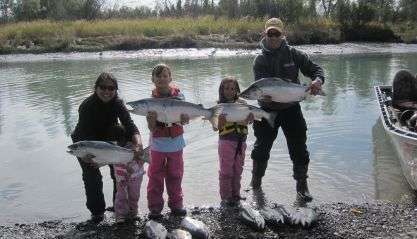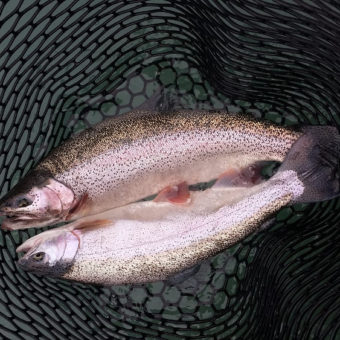 Alaska Steelhead Fishing on the Kenai Peninsula. When most people think of steelhead they think of places like Washington’s Olympic Peninsula, the Rogue in Oregon or the Smith in Northern California. When most Alaska waters are frozen shut, winter steelheading is alive and well in the Pacific Northwest (El NIno permitting). But in the Fall, before the freeze, a substantial number of mature steelhead return to a handful of small rivers on the Southern Kenai Peninsula. These fish are big, bright, and very aggressive.
Alaska Steelhead Fishing on the Kenai Peninsula. When most people think of steelhead they think of places like Washington’s Olympic Peninsula, the Rogue in Oregon or the Smith in Northern California. When most Alaska waters are frozen shut, winter steelheading is alive and well in the Pacific Northwest (El NIno permitting). But in the Fall, before the freeze, a substantial number of mature steelhead return to a handful of small rivers on the Southern Kenai Peninsula. These fish are big, bright, and very aggressive.
If you are used to pursuing steelhead in a redwood forests criss-crossed by murky green rivers, then fishing these tiny coastal creeks in Alaska will be weird. The water is not green, ever, and there’s no redwoods for thousands of miles. You can wade across 90% of the water. The color of the water is brown, but not a dirty brown. It’s the brown that results from clear water and a dark, rocky, mossy bottom. All these rivers have meandering mouths in muddy tidal flats which give way less than a mile from the salt to shallow, gravel riffles. They are less than 15 yards wide in most places and less than 10 in many. They are never more than four feet deep and yet despite the clear water, the mix of vegetation, rocks and deadfall, conceal fish remarkably well. Compared to the turquoise green flow of the mighty Kenai, these rivers are tiny but they can indeed be full of fish. After earlier returns of King, Pink and Silver salmon, September on the Anchor River or Deep Creek is a crossroads. Aside from a few late run cohos, the steady pulse of returning salmon has all but ceased. Spawning salmon in different stages of death, lace the entire river system. In the perpetual tides of early September, new life enters these waters from the ocean depths of Cook Inlet. Silver missles with crimson backs push their way into their natal streams.
 All steelhead fishing on Kenai Peninsula rivers is catch and release. Your are not allowed to use bait and your artificial lure must be single hook and barbless. Artificial only means you need to do your best to artificially create something a steelhead wants to eat or at least attack. Of course the most obvious and probably the most consistent lure is an egg imitation. I like a single egg but any number of imitation salmon eggs are effective. Smaller glo bugs or corkies in a washed out pink color have been my favorites. The key to success seems to be the ability to read water and properly present your offering. Choosing the right amount of weight is very important. For these smaller rivers, slinkys in the 2 – 6 bbs range are perfect. Your egg needs to have the basic drift qualities of the real thing. It needs to find those hidden indentations on the bottom, behind rocks and under banks. When you put your tiny egg in these spots with persistence and consistency, the result will be an unexpected but dramatic take that assures you it has all been worth it. The Steelhead seem possessed with an aggressive, dominant presence in the river and they reward a persistent angler with a very rememberable angling experience.
All steelhead fishing on Kenai Peninsula rivers is catch and release. Your are not allowed to use bait and your artificial lure must be single hook and barbless. Artificial only means you need to do your best to artificially create something a steelhead wants to eat or at least attack. Of course the most obvious and probably the most consistent lure is an egg imitation. I like a single egg but any number of imitation salmon eggs are effective. Smaller glo bugs or corkies in a washed out pink color have been my favorites. The key to success seems to be the ability to read water and properly present your offering. Choosing the right amount of weight is very important. For these smaller rivers, slinkys in the 2 – 6 bbs range are perfect. Your egg needs to have the basic drift qualities of the real thing. It needs to find those hidden indentations on the bottom, behind rocks and under banks. When you put your tiny egg in these spots with persistence and consistency, the result will be an unexpected but dramatic take that assures you it has all been worth it. The Steelhead seem possessed with an aggressive, dominant presence in the river and they reward a persistent angler with a very rememberable angling experience.
The clear water gives the washed out egg an excellent presentation. Dollies to 20 inches constantly attack your single egg and they are very fun to catch. The intoxicating consistency of catching a bunch of Dolly Varden is instantly forgotten by the sobering head shake of a fresh steelie. In this small water it’s tough to predict what these powerful fish may do. Hooking a steelhead in one hole and landing it in another is pretty common. You just need to keep the line tight and stay in control all while ice skating on rocks. I’ve gone in, more than once, and so have most of my friends.
Another excellent artificial offering is a flesh imitation. Steelhead do take advantage of eggs and salmon flesh as a source of protein before and after their spawn. A well presented yarn fly made to replicate a nice chunk of orange or pink salmon meat is equally if not more effective than the single egg. A pinch of orange glo bug yarn mixed with a bit of Oregon cheese (that’s a color of glo bug yarn) seem to be a hot combo. Just make it look like a chunk of meat and these steelhead will turn their head.
These Southern Kenai Peninsula rivers, namely Crooked Creek, Deep Creek, Stariski Creek, the Ninilchik River and the Anchor River are all accessible via the Sterling Highway and are approx. one hour’s drive from Soldotna or 4 hours drive from Anchorage. You can expect to see very few people especially the more you choose to explore less accessible portions of the river. I have hardly even seen anyone but the people I’m with, unless I go down to the first couple of holes to fish the tide. These spots are easy to walk to from a state park, so there might be four or five other people, no big deal. All these rivers have trails where you can leave most everyone behind and explore different water.
Steelhead fishing in this part of Alaska is tough, much like it is everywhere else. The fall weather can be cold and increasingly unpredictable but the more elements you cram into the equation the more satisfaction you can take from your angling. As always keep informed about current regulations and when you slip that beautiful steelhead back into the water after the fight of your life, remember what you went through to make it all happen.

















































